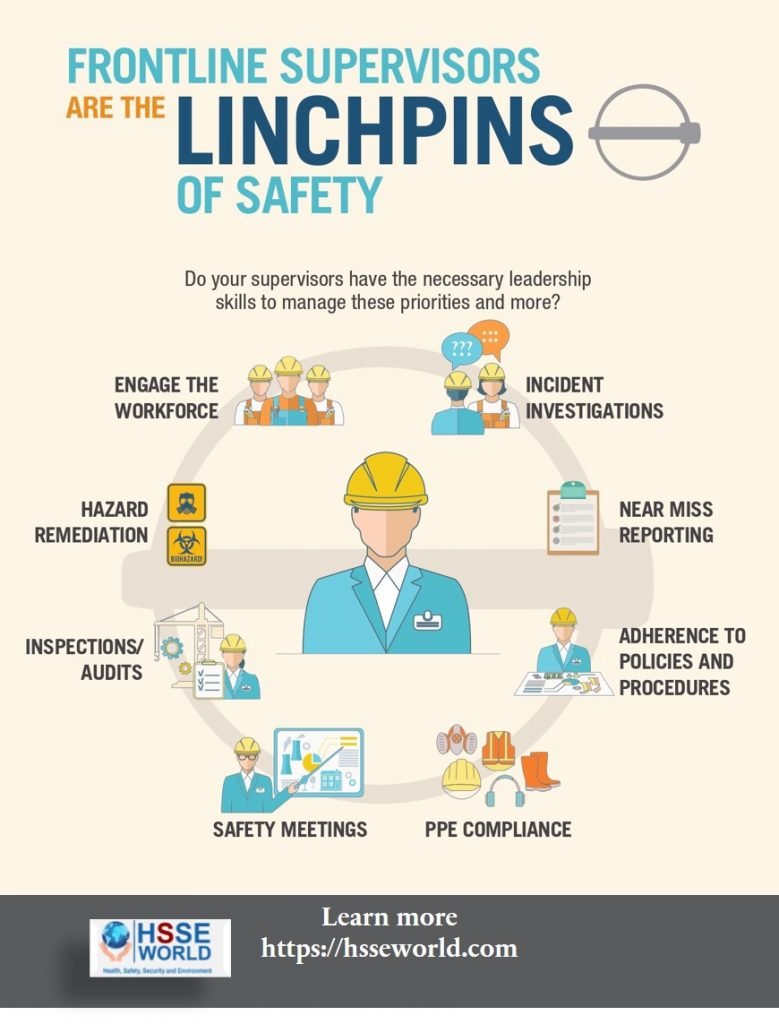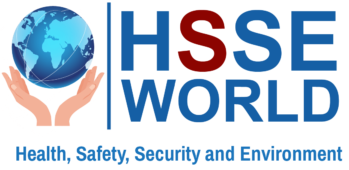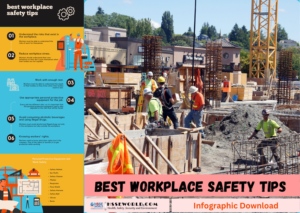Photo of the day: FrontLine supervisors are the LINCHPINS of safety
No matter the industry, in all my years of experience working across organizations, from the hourly workforce to the executive team, I have always found the most difficult job to be frontline supervision. Frontline supervisors have tremendous pressure from all directions. Their responsibilities are many and their decision-making power and control are limited. To add to their challenges, frontline supervisors often have limited experience in managing people. Many are promoted to supervision, not because of people management skills, but because of technical expertise. While technical expertise is important, it doesn’t help them with the most challenging part of their job managing the men and women who work for them.

Ironically, it’s the frontline supervisor who has the most influence on the performance of the people who actually produce the products and/or deliver the service. This is particularly true in safety. Frontline supervisors are the linchpins of safety. They bring all the pieces of safety management together. They are responsible for executing the vision and values at the frontline, ensuring procedures are complied with, implementing a myriad of safety decisions, and ultimately ensuring that the workforce is safe. Their role requires them to motivate and engage frontline employees to participate fully in safety and yet they rarely have adequate training or coaching in how to do it.
Engagement requires good leadership skills. The old-style command and control management that is too often the model for supervision simply will not foster engagement. Here are 5 ways frontline supervisors can improve their leadership skills and engage their direct reports in safety improvement:
- Build Relationships. It’s no coincidence that supervisors who have strong relationships with their crews tend to have safer crews. Time spent working on getting to know direct reports, showing care and concern and building trust pays off in spades. Employees who feel like a valued part of a team rather than just a pair of hands to get the job done are much more likely to be engaged.
- Respond to Hazards. Frontline employees gauge how truly important safety is in an organization by management’s willingness to take care of hazardous conditions. When management does a good job of taking care of hazards, employees are willing to participate more fully in safety. Since frontline supervisors are the “face” of management, it is important they do all they can to remediate safety hazards.
- Encourage Near Miss Reporting. Near misses uncover weaknesses in safety systems and processes that, in turn, enable changes to be made to prevent future incidents. Unfortunately, most frontline employees avoid reporting near misses out of fear of negative consequences. Supervisors need to be deliberate in their use of positive reinforcement when near misses are reported in order to tap into this valuable source of information.
- Eliminate Blame. Blame is the enemy of engagement but is too often the outcome of incident investigations. In truth, most safety incidents are the coming together of a number of factors (conditions, behaviors, systemic weaknesses). To pin the blame on one person or one act is almost always overly simplistic. Even in cases where an employee clearly did something that contributed to the incident, blame (and the negative consequences that usually follow) rarely solves the problem. By working to understand and eliminate the behavioral root causes, supervisors will strengthen prevention and build engagement.
- Use More Positive Reinforcement. Being truly engaged in safety is voluntary. An employee who works hard but doesn’t speak up at safety meetings, report hazards, or provide feedback to a peer is not likely to get fired. Engagement is discretionary and the only way to get discretionary effort is through positive reinforcement. By more frequently acknowledging what employees do well, supervisors can not only strengthen safe behaviors, they can also foster engagement.
Frontline supervisors who are skilled at building engagement earn the respect and commitment of their team, improve overall performance, and keep workers safe on the job.
Download the photo
More photos:
- Photo of the day: 10 Essential Safety Tips for Driving in Hot Weather Conditions
- Photo of the day: best workplace safety tips
- Photo of the day: The Importance of Stop Work Authority in Maintaining Workplace Safety
- Photo of the day: Tomorrow’s Reward for Working Safely Today: Cultivating a Culture of Safety
- Photo of the day: Preventing slips and trips at work
- Photo of the day: Learn the DRSABCD action Plan
- Working with Electricity Electrical Accidents Guide for Electrical Workers
- Photo of the day: Hearing Protection Device Selection
- Photo of the day: If An Earthquake Shakes You-Infographic free
- Fire Safety Posters Free Download
- Photo of the day: First Aid for Electrical Burns-Infographic free
- Infographic: First Aid for Cuts and Scrapes free download
- Photo of The day: Work Safe with Lasers-Laser Safety free
- Photo of the day: Working Safely with chemicals and chemical Management
- Photo of the day: Safe work practices when using MEWPs ( updated)
- Photo of the day: Preventing Common Kitchen Hazards
- Photo of the day: Safe handling of Gas Cylinders and lecture bottles
- Photo of the day: Forklift Stability Triangle
- Photo of the day: Defective Tools Safe Work Practice
- Photo of the day: Lift With Your Legs Not With Your Back
- Photo of the day: First Aid for burns
- Photo of the day: The 7 Principles of HACCP
- Photo of the day: Working Safely with Suspended Loads
- Photo of the day: Heat Stroke First Aid and safety posters
- Photo of the day: Near-Miss Reporting and Posters
- Photo of the day: Ergonomic chair and office chair safety tips
- Photo of the day: Whole Body Vibration
- Photo of the day: Substation Safety Equipment
- Photo of the day: Bypassing Safety Controls Rules
- Photo of the day: Lightning Safety Tips
- Photo of the day: Overhead Power lines Clearance
- Photo of the day: Floor Marking
- Photo of the day: Types of Foot Protection
- Photo of the day: Types of Hand Protection
- Photo of the day: Lockout and Tagout Safety
- Photo of the day: Fall Protection Plans
- Photo of the day: Flood Safety Tips
- Photo of the day: Read All Labels Work safe
- Photo of the day: Run Project safely with Crane Hand Signals
- Photo of the day: Flagman and Traffic control
- Photo of the day: Managing Risks of Exposure to Solvents in the workplace
- Photo of the day: Scissor Lift Safety
- Photo of the day: HSE Bulletin Board
- Photo of the day: Arc-Fault Circuit Interrupters (AFCI)
- Photo of the day: Safe use of ladders and step ladders
- Photo of the day: Concrete Truck Driver Hand Signals
- Photo of the day: Extension Cord Safety Tips
- Photo of the day: Protect your Head
- Photo of the day: choosing the right Anchorage
- Photo of the day: Work-Related Asthma
- Photo of the day: Top FIVE Heavy Equipment Construction Site Safety Tips
- Photo of the day: sun safety in the workplace
- Photo of the day: Cannabis and Impairment in the Workplace
- Photo of the day: Position for safety and comfort-Safety Tips
- Photo of the day: Generator Safety
- Photo of the day: Controlling COVID-19 in the Workplace-Physical Barriers
- Photo of the day: Manual Material handling
- Photo of the day: Personal Protective Equipment last resort
- Photo of the day: WHMIS 2015 – Pictograms
- Photo of the day: Indoor Air Quality
- Photo of the day: Noise in the affected workplace
- Photo of the day: Fatigue at Work
- Photo of the day: Don’t be Driven to Distraction
- Photo of the day: working in heat and Humidex Rating
- How to use Plate Clamps Safely: Safety Moment#34
- Photo of the day: Sitting at work
- Photo of the day: 5 ways to reduce the risk of Slipping and Tripping
- Photo of the day: Preventing the spread of contagious illness
- Photo of the day: Incident Investigations
- Photo of the day: 10 Scaffold Safety Essentials
- Photo of the day: Effective Health and Safety Committees
- Photo of the day: New worker Orientation & Safety Orientation checklist
- Photo of the day: Workplace Inspection
- Photo of the day: musculoskeletal disorders
- Photo of the day: Emergency preparedness in the workplace
- Photo of the day: Mental health in the workplace
- Photo of the day: Trenching Safety Tips That Can Save a Life
- Photo of the day: Dangerous Goods Classes
- Photo of the day: Safety Equipment for Confined Spaces
- Photo of the day: Tips to reduce Heat stress in the workplace
- Photo of the day: hierarchy of controls
- Your steps to chemical safety
- H2S Gas and how to handle its Emergency
- Photo of the day: Importance of Mock drill and Fire Action Emergency Procedure
- Photo of the day: Choosing the Right Face Mask and the difference between a respirator and face mask
- Photo of the day: Confined space safety Precautions
- Breath Safely: The Proper Use of Respiratory Protection
- Photo of the day: Electric shock survival
- Photo of the day: Chemical Spill Emergency Response
- Photo of the day: Construction Site fire Safety
- Photo of the day: Confined Space rescue
- Photo of the day: Conveyors Safety Tips
- Photo of the day: 5 Essential outcomes of an effective leadership survey process




1 thought on “Photo of the day: FrontLine supervisors are the LINCHPINS of safety”